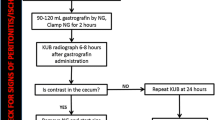Abstract
Recessive dystrophic epidermolysis bullosa (RDEB) is associated with high nutritional demands, esophageal strictures and dysphagia. About one quarter of the patients require gastrostomy tube placement to maintain adequate nutritional status. To minimize trauma to the skin and pharyngoesophageal mucosa caused by commonly used gastrostomy tube insertion techniques, we used a non-endoscopic, percutaneous, image-guided approach. This approach combines the use of ultrasound for mapping of the liver and spleen, water-soluble contrast enema to visualize the colon, and gastric insufflation to define the stomach. The gastrostomy tube is replaced by a low-profile button gastrostomy tube 10–12 weeks postoperatively. The five female patients reported in this series ranged in age from 6 to 9 years. They all tolerated the procedure well and no perioperative complications were encountered. All were able to tolerate feedings on postoperative day 1 and all underwent successful replacement of gastrostomy tubes by low-profile button tubes. Our experience suggests that a non-endoscopic, image-guided approach to gastrostomy tube placement offers a safe, effective, and minimally traumatic alternative to more commonly used approaches. It minimizes the risk of procedure-related morbidity and leads to overall improvement in the quality of life. As such, we strongly recommend that it be included in the treatment armamentarium for patients with epidermolysis bullosa and nutritional failure.


Similar content being viewed by others
References
Pfendner EG, Bruckner A, Conget P, Mellerio J et al (2007) Basic science of epidermolysis bullosa and diagnostic and molecular characterization: proceedings of the IInd international symposium on epidermolysis bullosa, Santiago, Chile, 2005. Int J Dermatol 46(8):781–794
Allman S, Haynes L, MacKinnon P, Atherton DJ (1992) Nutrition in dystrophic epidermolysis bullosa. Pediatr Dermatol 9:231–238
Birge K (1995) Nutrition management of patients with epidermolysis bullosa. J Am Diet Assoc 95:575–579
Mellerio JE, Weiner M, Denyer JE, Pillay EI et al (2007) Medical management of epidermolysis bullosa: proceedings of the IInd international symposium on epidermolysis bullosa, Santiago, Chile, 2005. Int J Dermatol 46(8):795–800
Azizkhan RG, Denyer JE, Mellerio JE, Gonzalez R et al (2007) Surgical management of epidermolysis bullosa: proceedings of the IInd international symposium on epidermolysis bullosa, Santiago, Chile, 2005. Int J Dermatol 46(8):801–808
Azizkhan RG, Stehr W, Cohen AP, Wittkugel E et al (2006) Esophageal strictures in children with recessive dystrophic epidermolysis bullosa: an 11-year experience with fluoroscopically guided balloon dilatation. J Pediatr Surg 41:55–60
Castillo RO, Davies YK, Lin YC et al (2002) Management of esophageal strictures in children with recesssive dystrophic epidermolysis bullosa. J Pediatr Gastroenterol Nutr 34:535–541
Heyman mB, Zwass M, Applebaum M et al (1993) Chronic recurrent esophageal strictures treated with balloon dilatation in children with autosomal recessive epidermolysis bullosa dystrophica. Am J Gastroenterol 88:953–957
Fine JD, Johnson LB, Suchindran C, Bauer EA et al (1999) Extracutaneous manifestations of inherited epidermolysis bullosa. The national epidermolysis bullosa registry experience. In: Fine JD, Bauer EA, McGuire J, Moshell A (eds) Epidermolysis bullosa: clinical, epidemiologic, and laboratory advances, and the findings of the National Epidermolysis Bullosa Registry. Johns Hopkins University Press, Baltimore, pp 147–174
Anderson SH, Meenan J, Williams KN et al (2004) Efficacy and safety of endoscopic dilation of esophageal strictures in epidermolysis bullosa. Gastrointest Endosc 59:28–32
Kay M, Wyllie R (2002) Endoscopic dilatation of esophageal strictures in recessive dystrophic epidermolysis bullosa: new equipment, new techniques. J Pediatr Gastroenterol Nutr 34:515–518
Cory DA, Fitzgerald JF, Cohen MD (1988) Percutaneous nonendoscopic gastrostomy in children. Am J Roentgenol 151:995–997
Ho SG, Marchinkow LO, Legiehn GM, Munk PL et al (2001) Radiological percutaneous gastrostomy. Clin Radiol 56:902–910
Ozmen MN, Akhan O (2002) Percutaneous radiologic gastrostomy. Eur J Radiol 43:186–195
Iohom G, Lyons B (2001) Anesthesia for children with epidermolysis bullosa: a review of 20 years’ experience. Eur J Anaesthesiol 18:745–754
Lin Y-C, Golianu B (2006) Anesthesia and pain management for pediatric patients with dystrophic epidermolysis bullosa. J Clinic Anesth 18:268–271
Garcia A, Flores RM, Schattner M, Kraus D, Bains MS et al (2006) Endoscopic retrograde dilation of completely occlusive esophageal strictures. Ann Thorac Surg 82:1240–1243
Author information
Authors and Affiliations
Corresponding author
Rights and permissions
About this article
Cite this article
Stehr, W., Farrell, M.K., Lucky, A.W. et al. Non-endoscopic percutaneous gastrostomy placement in children with recessive dystrophic epidermolysis bullosa. Pediatr Surg Int 24, 349–354 (2008). https://doi.org/10.1007/s00383-007-2100-x
Accepted:
Published:
Issue Date:
DOI: https://doi.org/10.1007/s00383-007-2100-x




